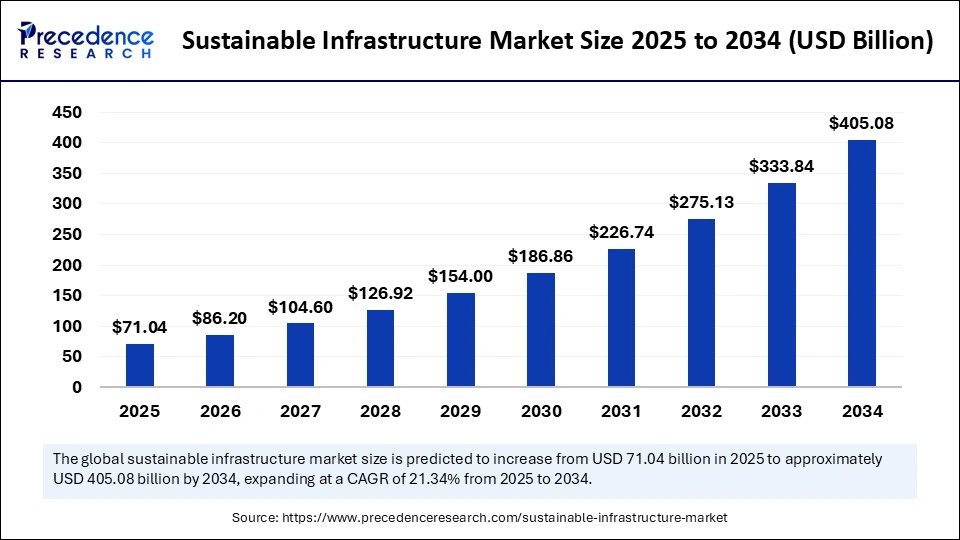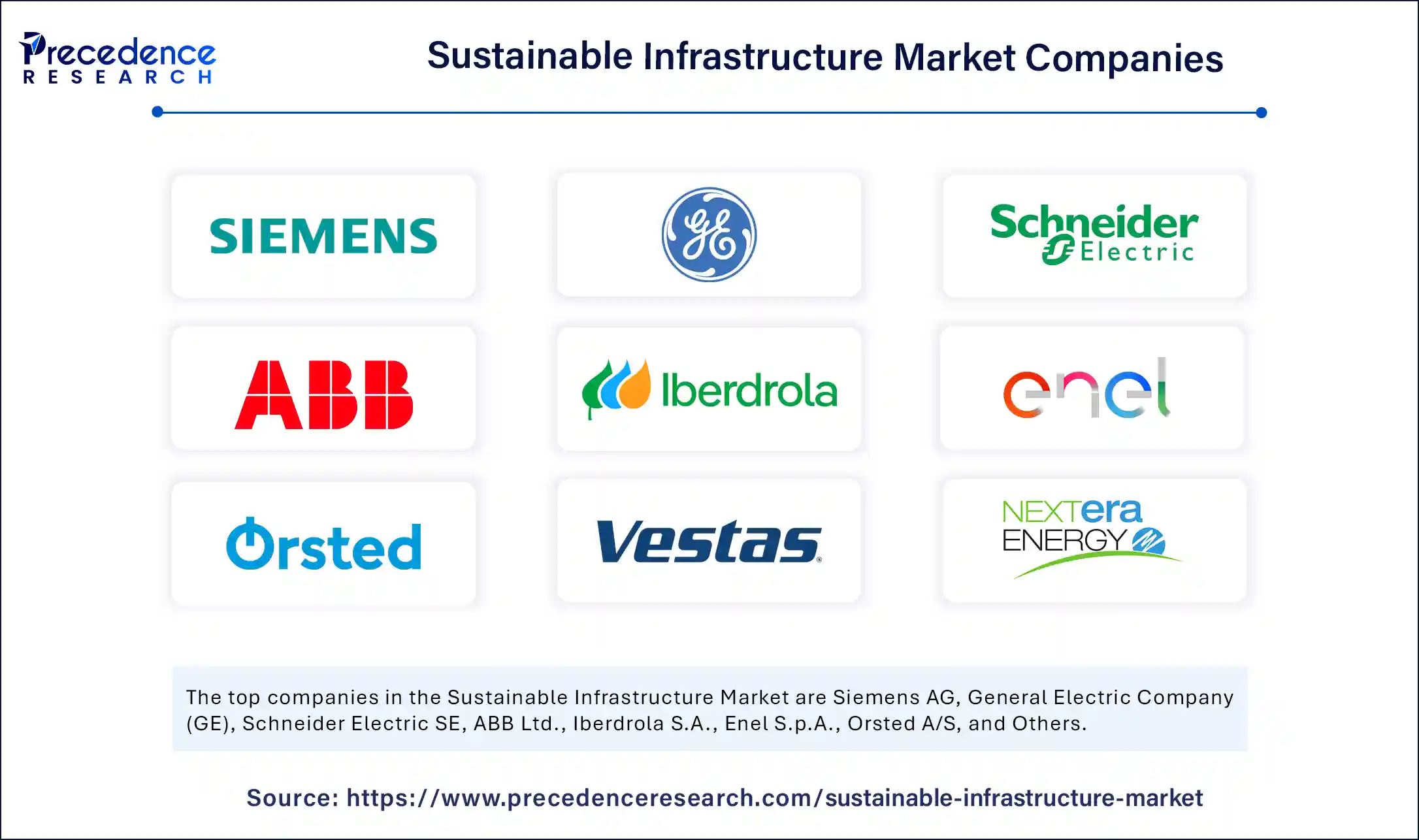The sustainable infrastructure market is set to skyrocket from $71.04 billion in 2025 to $405.08 billion by 2034, riding a strong CAGR of 21.34% thanks to relentless climate goals, government regulations, rapid urbanization, and massive public–private sector investments. Innovations in materials and digital technology, particularly through AI, are opening new avenues for efficiency and resilience in global infrastructure planning, construction, and maintenance.

Sustainable Infrastructure Market Key Insights
-
The global sustainable infrastructure market will reach $405.08 billion by 2034, up from $71.04 billion in 2025, at a CAGR of 21.34%.
-
Asia Pacific claimed the largest share (42%) in 2024 and is forecast to hit $172.16 billion by 2034.
-
Europe is projected to record the fastest growth rate (CAGR) to 2034, fueled by the European Green Deal and robust investments.
-
Renewable infrastructure accounts for the largest segment (35% share in 2024), driven by cost-friendly solar and wind energy adoption.
-
Leading players include Skanska, Stantec Inc., Siemens (project development), Brambles Ltd, Element Logic, ShipBob (equipment handling), and Corpseed, Blue Berkhs Shipping Pvt Ltd, Wire Consultancy (safety and compliance).
-
The public sector leads investments, with nearly 45% share in 2024, while public–private partnerships see the fastest projected growth.
Get this report to explore global market size, share, CAGR, and trends, featuring detailed segmental analysis and an insightful competitive landscape overview @ https://www.precedenceresearch.com/sample/6749
The Transformative Role of AI in Sustainable Infrastructure
AI is reshaping sustainable infrastructure by making project design, construction, and operations smarter and more cost-effective. Predictive analytics are harnessed to optimize resource allocation, create energy-efficient urban plans, and simulate innovative material solutions that elevate sustainability standards. AI-powered systems analyze massive sensor datasets, enabling proactive equipment maintenance, recycling management, and early defect detection, which drive down operational costs and minimize environmental impact.
Looking ahead, AI models integrate seamlessly with digital twins, smart cities, renewable energy grids, and advanced waste management systems. This ushering in of data-driven, resilient infrastructure addresses climate challenges while reducing unnecessary waste generation and promoting eco-friendly development in real time.
What’s Fueling Market Growth?
Several critical forces are catalyzing the sustainable infrastructure boom:
-
Climate Change Adaptation: Governments and cities worldwide are seeking durable solutions to extreme weather and escalating emissions.
-
Urban Population Spikes: Rapid urbanization increases the demand for energy-efficient construction and clean transport solutions.
-
Government Mandates and Incentives: Policy frameworks, like the European Green Deal and green building standards, are pushing sector growth.
-
Technological Innovations: Advances in monitoring systems, bio-based composites, and smart city platforms accelerate adoption.
-
Financial Investments: Both public agencies and private firms, particularly in Asia Pacific and Europe, continue to pour capital into resilient infrastructure and net-zero initiatives.
Sustainable Infrastructure Market Scope
| Report Coverage | Details |
| Market Size by 2034 | USD 405.08 Billion |
| Market Size in 2025 | USD 71.04 Billion |
| Market Size in 2024 | USD 58.55 Billion |
| Market Growth Rate from 2025 to 2034 | CAGR of 21.34% |
| Dominating Region | Asia Pacific |
| Fastest Growing Region | Europe |
| Base Year | 2024 |
| Forecast Period | 2025 to 2034 |
| Segments Covered | Type of Infrastructure, Component, Investment Model, End-Use Sector, and Region |
| Regions Covered | North America, Europe, Asia-Pacific, Latin America, and Middle East & Africa |
Sustainable Infrastructure Market Opportunity and Trends
How Will Eco-Friendly Growth Shape the Construction Industry?
Sustainable infrastructure is revolutionizing construction by introducing highly efficient, eco-friendly approaches. These developments stimulate economic growth through renewable energy, job creation, and innovative building materials, reducing overall operational costs.
Why Is the Renewable Infrastructure Segment Dominating?
The renewable infrastructure segment maintains leadership thanks to widespread solar and wind energy projects, which drastically lower emissions and bolster energy security. The downward trend in costs and increased accessibility further entrench its growth prospects worldwide.
Are Public-Private Partnerships Set to Redefine Project Delivery?
Public-private partnerships are increasingly pivotal, attracting private investments and sharing risk—making infrastructure delivery more efficient and appealing to global investors. These models also enhance cost efficiency and project feasibility for governments.
Sustainable Infrastructure Market Regional & Segmental Analysis
Asia Pacific: A Powerhouse of Growth
Asia Pacific led the market with a 42% share in 2024, supported by strong government mandates in India, China, and Japan, as well as dynamic private investment. The region is forecasted to reach $172.16 billion by 2034, highlighting unprecedented infrastructure buildout to meet climate goals.
Europe: Green Deals and Regulatory Drive
Europe’s rapid expansion is anchored by the EU’s Green Deal, investment bank financing, and long-term modernization efforts. The region demonstrates a clear regulatory vision, setting a strong example for carbon neutrality and energy grid revitalization.
Major Segments on the Rise
-
Renewable Infrastructure (35% market share in 2024)
-
Smart Cities (highest projected CAGR)
-
Construction Materials (40% share in 2024, led by eco-friendly innovations)
-
Monitoring & Control Systems (fastest-growing segment, driven by AI and grid integration)
-
Public Sector Projects (45% share)
-
Energy & Utilities (38% share, critical for economic health and security)
-
Building & Construction (fastest CAGR, supported by global green initiatives)
Sustainable Infrastructure Market Companies

- Siemens AG
- General Electric Company (GE)
- Schneider Electric SE
- ABB Ltd.
- Iberdrola S.A.
- Enel S.p.A.
- Orsted A/S
- Vestas Wind Systems A/S
- NextEra Energy Inc.
- SunPower Corporation
- First Solar Inc.
- Tesla Inc.
- Johnson Controls International plc
- Brookfield Renewable Partners L.P.
- ENGIE S.A.
- Others
Market Challenges & Cost Pressures
Despite surging growth, the market contends with:
-
Limited supplies of sustainable materials and technical shortcomings in extraction and application
-
Lack of skilled professionals for advanced construction and maintenance
-
Regional disparities in resource availability and workforce expertise
-
Cost pressures from high technology investments and evolving regulatory standards
Case Study: Smart Cities A Model for Carbon-Neutral Urbanization
Recent expansions in smart cities demonstrate how integrating AI-driven transport, waste management, and digital resource optimization drastically lowers urban emissions. These cities serve as templates for public–private investment, scalable deployment, and future-ready urban planning strategies.
Read Also: Structural Insulated Panels Market
You can place an order or ask any questions. Please feel free to contact us at sales@precedenceresearch.com |+1 804 441 9344